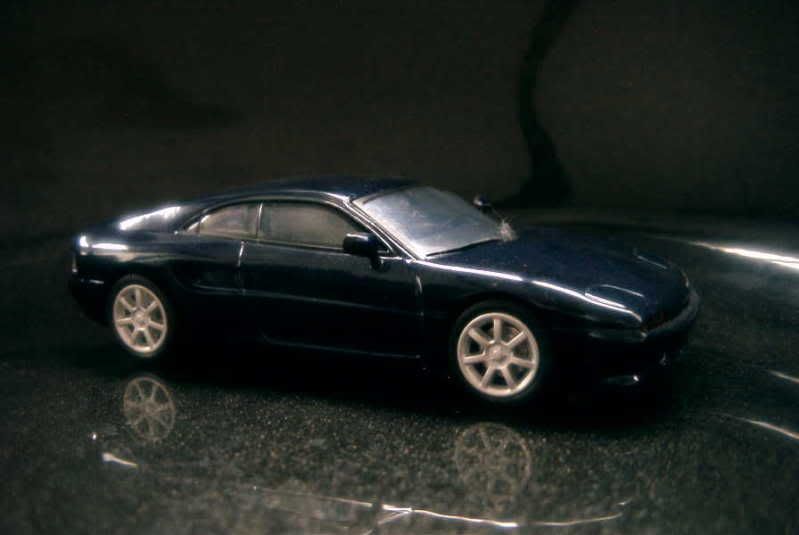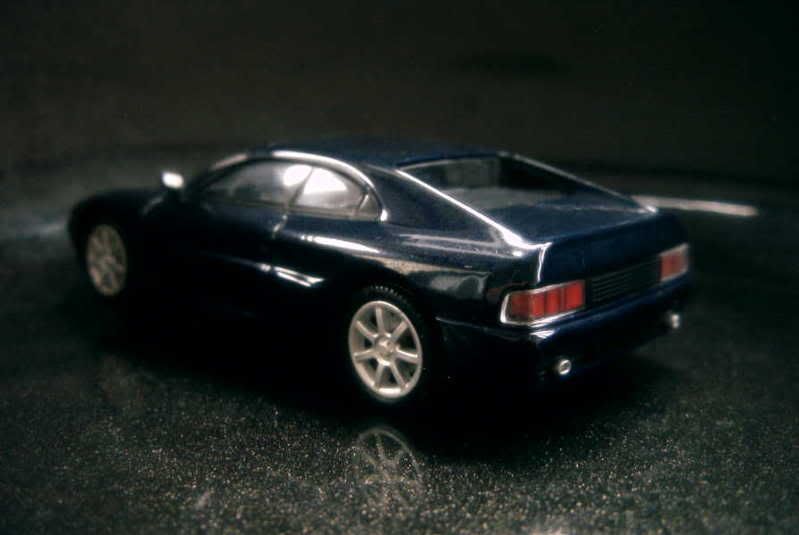A little history
A good friend of mine and fellow collector was once passing in front of the table my wife and I were occupying during one of the swapmeets that the collectors' club I used to belonged to at this time was holding. Though he has quite an extensive collection I had never seen a Venturi among his models, so I asked him if he wouldn't be interested by the one we were then selling. He first refused, arguing that he indeed had one of those, but it soon appeared that he was confused about this car, despite his impressive knowledge. When I told him that it was actually a Venturi, he had to admit that he had no idea what this brand could be.
My friend is certainly not an isolated case, for it is somewhat surprising that Venturi doesn't seem able to generate more publicity around its name after a quarter of a century in business.
When it was born in 1984, Venturi wasn't even named Venturi... but M.V.S., for Manufacture de Voitures de Sport (French for "Sportscars Manufacture"). On the other hand, their first model was indeed called Venturi.
The two founders of M.V.S., two engineers formerly employed by Heuliez, set themselves as a goal nothing less than creating a French equivalent to the most celebrated sportscars of the time. The means of the small company were rather slim, though. Unlike Porsche or Ferrari, M.V.S. would have to borrow most of its mechanical parts from other manufacturers, while its philosophy imposed that these manufacturers would also be French. The Venturi ended up being fitted with a PRV engine provided by Peugeot, matted with a Renault gearbox.
True, the PRV V6 engine never made thoroughbreds out of the Volvo 264, the Peugeot 604 or the Renault 30, and its choice as powerplant for the short-lived DeLorean DMC12 is still subject to controversy. Its critics nevertheless have to admit that it did a wonderful job powering the W.M.'s on the racing circuits - as a reminder, a PRV-engined W.M. still holds - and will probably always do as modern motor racing is ever more security-minded - the record for the higher speed ever achieved during a race, passing the 400 kph-mark on Mulsanne straight during the 1989 Le Mans 24 hours.
As the W.M. team, the M.V.S. engineers were among those who fared well with the PRV. As soon as it was released, the Venturi got the distinction of being the fastest French road car ever. The fact that the previous record holder, the sublime Facel-Vega "Facel II" coupe, had seen its production halted twenty years earlier illustrates better than any lengthy discourse the disarray into which high-performance automobiles construction had felt in France during these two decades.
The M.V.S. Venturi enjoyed good publicity in France but, already back then, wasn't much noticed outside of the borders of its native country. Image does almost everything to attract potential customers to Porsche or Ferrari showrooms, to keep as examples the two brands cited above. One of the earliest moves of the M.V.S. management was to acknowledge the blandness of their company's name, and consequently substitute "Venturi" for it. No one could imagine this would suffice to improve the manufacturer's visibility - entering motor racing was the next logical step.
A short involvement in Formula One, through the Larrousse team in 1992, went nowhere. Venturi then decided to develop its road car into a GT. Out of the then-produced 400 GT model was designed a special homologation version, the 400 GTR, which performed quite well at the Le Mans 24 hours and in other endurance races during the early- to mid-Nineties.
Success on the track didn't push the sales of the road cars as high as the company expected, though. During the end of the decade, the company switched hands several times. Each new owner had great plans, but the future remained bleak for the tiny factory.
The sun shone again, quite unexpectedly, from 2001 on. A rich investor from Monaco, Gildo Palanca Pastor, acquired Venturi with plans to develop environment-friendly vehicles. Venturi, which has always tried to position itself as an innovative outfit (the 400 GT was, for example, the first road car in the world to feature carbon disk brakes), released since then the first electric sportscar, the Fétish, and the first energy-autonomous automobile, the prototype Electric.
Today, Venturi's managers have many projects in mind, as can be seen on the company's internet site at http://www.venturi.fr.
About the model
Model: Venturi Atlantique 300
Year: 1996
Maker: Norev
Scale: 1/43
Distributed by: Hachette as no.100 of its Voitures Françaises de Collection press series
Acquired: brand new, in June 2006, in Souillac, France
Norev's model is correctly made though, distributed by Hachette as a "press" release, it would have benefited from a few refinements. My main complaints would go to the lack of any identification both front and rear, as nowhere on the car appear the names of the brand or of the model. Norev also did a poor job with the rear lights: they're simply figured by red paint quite oddly covered by a piece of clear plastic, as can be seen on the following pictures. Should I have to rate this model, I'd give it 10/20, but rather than the quality of its details, its originality makes its charm.


A good friend of mine and fellow collector was once passing in front of the table my wife and I were occupying during one of the swapmeets that the collectors' club I used to belonged to at this time was holding. Though he has quite an extensive collection I had never seen a Venturi among his models, so I asked him if he wouldn't be interested by the one we were then selling. He first refused, arguing that he indeed had one of those, but it soon appeared that he was confused about this car, despite his impressive knowledge. When I told him that it was actually a Venturi, he had to admit that he had no idea what this brand could be.
My friend is certainly not an isolated case, for it is somewhat surprising that Venturi doesn't seem able to generate more publicity around its name after a quarter of a century in business.
When it was born in 1984, Venturi wasn't even named Venturi... but M.V.S., for Manufacture de Voitures de Sport (French for "Sportscars Manufacture"). On the other hand, their first model was indeed called Venturi.
The two founders of M.V.S., two engineers formerly employed by Heuliez, set themselves as a goal nothing less than creating a French equivalent to the most celebrated sportscars of the time. The means of the small company were rather slim, though. Unlike Porsche or Ferrari, M.V.S. would have to borrow most of its mechanical parts from other manufacturers, while its philosophy imposed that these manufacturers would also be French. The Venturi ended up being fitted with a PRV engine provided by Peugeot, matted with a Renault gearbox.
True, the PRV V6 engine never made thoroughbreds out of the Volvo 264, the Peugeot 604 or the Renault 30, and its choice as powerplant for the short-lived DeLorean DMC12 is still subject to controversy. Its critics nevertheless have to admit that it did a wonderful job powering the W.M.'s on the racing circuits - as a reminder, a PRV-engined W.M. still holds - and will probably always do as modern motor racing is ever more security-minded - the record for the higher speed ever achieved during a race, passing the 400 kph-mark on Mulsanne straight during the 1989 Le Mans 24 hours.
As the W.M. team, the M.V.S. engineers were among those who fared well with the PRV. As soon as it was released, the Venturi got the distinction of being the fastest French road car ever. The fact that the previous record holder, the sublime Facel-Vega "Facel II" coupe, had seen its production halted twenty years earlier illustrates better than any lengthy discourse the disarray into which high-performance automobiles construction had felt in France during these two decades.
The M.V.S. Venturi enjoyed good publicity in France but, already back then, wasn't much noticed outside of the borders of its native country. Image does almost everything to attract potential customers to Porsche or Ferrari showrooms, to keep as examples the two brands cited above. One of the earliest moves of the M.V.S. management was to acknowledge the blandness of their company's name, and consequently substitute "Venturi" for it. No one could imagine this would suffice to improve the manufacturer's visibility - entering motor racing was the next logical step.
A short involvement in Formula One, through the Larrousse team in 1992, went nowhere. Venturi then decided to develop its road car into a GT. Out of the then-produced 400 GT model was designed a special homologation version, the 400 GTR, which performed quite well at the Le Mans 24 hours and in other endurance races during the early- to mid-Nineties.
Success on the track didn't push the sales of the road cars as high as the company expected, though. During the end of the decade, the company switched hands several times. Each new owner had great plans, but the future remained bleak for the tiny factory.
The sun shone again, quite unexpectedly, from 2001 on. A rich investor from Monaco, Gildo Palanca Pastor, acquired Venturi with plans to develop environment-friendly vehicles. Venturi, which has always tried to position itself as an innovative outfit (the 400 GT was, for example, the first road car in the world to feature carbon disk brakes), released since then the first electric sportscar, the Fétish, and the first energy-autonomous automobile, the prototype Electric.
Today, Venturi's managers have many projects in mind, as can be seen on the company's internet site at http://www.venturi.fr.
About the model
Model: Venturi Atlantique 300
Year: 1996
Maker: Norev
Scale: 1/43
Distributed by: Hachette as no.100 of its Voitures Françaises de Collection press series
Acquired: brand new, in June 2006, in Souillac, France
Norev's model is correctly made though, distributed by Hachette as a "press" release, it would have benefited from a few refinements. My main complaints would go to the lack of any identification both front and rear, as nowhere on the car appear the names of the brand or of the model. Norev also did a poor job with the rear lights: they're simply figured by red paint quite oddly covered by a piece of clear plastic, as can be seen on the following pictures. Should I have to rate this model, I'd give it 10/20, but rather than the quality of its details, its originality makes its charm.





No comments:
Post a Comment